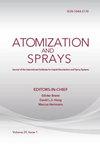推导用于各种燃料喷雾模拟的开尔文-赫姆霍兹-瑞利-泰勒(KH-RT)破裂模型中的通用常数集
IF 0.9
4区 工程技术
Q4 ENGINEERING, CHEMICAL
引用次数: 0
摘要
开尔文-赫姆霍兹-瑞利-泰勒(KH-RT)破裂模型已被广泛用于燃料喷雾模拟。在 KH-RT 模型中,有五个重要的经验模型参数,需要针对不同工作条件下的不同燃料进行仔细校准。在这项工作中,对 KH-RT 破裂模型中的模型常数进行的全局敏感性分析表明,随着燃料类型的变化,用于切换 KH 和 RT 机制的模型常数 Cb 是影响模拟精度的主要参数。为了确定汽油喷雾的最佳 Cb,喷雾模拟的计算流体动力学(CFD)程序与进化遗传算法相结合,得到了 Cb 与环境密度(ρamb)之间的定量关系。与柴油喷雾相比,汽油喷雾的 Cb 会降低,这是因为汽油的密度、粘度和表面张力较低,使得汽油喷雾在喷射后更容易形成较小的液滴。因此,在优化 Cb 时应考虑燃料特性的影响。通过阐明不同燃料的物理性质与其各自最佳 Cb 值之间的相关性,本研究将该公式扩展到二甲醚 (DME)、生物柴油和甲醇。验证结果表明,增强型 Cb 公式有效地再现了各种燃料的喷雾演变过程,与实验测量结果十分吻合。本文章由计算机程序翻译,如有差异,请以英文原文为准。
Derivation of a universal constant set in the Kelvin-Helmholtz Rayleigh-Taylor (KH-RT) breakup model for spray simulations of various fuels
The Kelvin-Helmholtz Rayleigh-Taylor (KH-RT) breakup model has been extensively utilized in fuel spray simulations. In the KH-RT model, there are five important empirical model parameters, which need to be calibrated carefully for different fuels under various operating conditions. In this work, the global sensitivity analysis of the model constants in the KH-RT breakup model reveals that the model constant for switching the KH and RT mechanisms, Cb, is a dominant parameter affecting the simulation accuracy with the variation of fuel type. To determine the optimal Cb for gasoline spray, the computational fluid dynamics (CFD) program of spray simulation is coupled with the evolutionary genetic algorithm to obtain a quantitative relationship between Cb and ambient density (ρamb). Compared with diesel spray, Cb for gasoline spray is reduced owing to its lower density, viscosity, and surface tension, making it easier for gasoline spray to form smaller droplets after injection. Therefore, the influence of fuel properties should be considered when optimizing Cb. By elucidating the correlation between the physical properties of different fuels and their respective optimal Cb values, this formula is extended to encompass dimethyl ether (DME), biodiesel, and methanol in the present study. The validation results affirm that the enhanced Cb formula effectively reproduces the evolution of the spray for a variety of fuels, aligning well with experimental measurements.
求助全文
通过发布文献求助,成功后即可免费获取论文全文。
去求助
来源期刊

Atomization and Sprays
工程技术-材料科学:综合
CiteScore
2.10
自引率
16.70%
发文量
54
审稿时长
1.7 months
期刊介绍:
The application and utilization of sprays is not new, and in modern society, it is extensive enough that almost every industry and household uses some form of sprays. What is new is an increasing scientific interest in atomization - the need to understand the physical structure of liquids under conditions of higher shear rates and interaction with gaseous flow. This need is being met with the publication of Atomization and Sprays, an authoritative, international journal presenting high quality research, applications, and review papers.
 求助内容:
求助内容: 应助结果提醒方式:
应助结果提醒方式:


